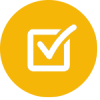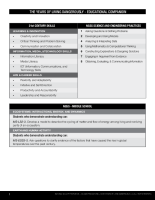
Download the standards tables for Middle School Lesson 4: 21st-Century Skills and NGSS, CCSS, and NCSS.
You can also read the different standards applicable to Middle School Lesson 4 here.
21st Century Skills
Learning & Innovation
- Creativity and Innovation
- Critical Thinking and Problem Solving
- Communication and Collaboration
Information, Media, &Technology Skills
- Information Literacy
- Media Literacy
- ICT (Information, Communications, and Technology Literacy
Life & Career Skills
- Flexibility and Adaptability
- Initiative and Self-Direction
- Productivity and Accountability
- Leadership and Responsibility
NGSS Science and Engineering Practices
- Asking Questions and Defining Problems
- Developing & Using Models
- Analyzing & Interpreting Data
- Using Mathematics & Computational Thinking
- Constructing Explanations and Designing Solutions
- Engaging in Argument from Evidence
- Obtaining, Evaluating, & Communicating Information
NGSS – MIDDLE SCHOOL
Ecosystems: Interactions, Energy, and Dynamics
Students who demonstrate understanding can:
MS-LS2-3. Develop a model to describe the cycling of matter and flow of energy among living and nonliving parts of an ecosystem.
Earth and Human Activity
Students who demonstrate understanding can:
MS-ESS3-5. Ask questions to clarify evidence of the factors that have caused the rise in global temperatures over the past century.
CCSS – ELA/Literacy – Middle School
Key Ideas and Details
RST.6-8.3 Follow precisely a complex multistep procedure when carrying out experiments, taking measurements, or performing technical tasks.of the information.
Craft and Structure
RST.6-8.4 Determine the meaning of symbols, key terms, and other domain- specific words and phrases as they are used in a specific scientific or technical context relevant to grades 6–8 texts and topics.
Integrations of Knowledge and Ideas
RST.6-8.7 Integrate quantitative or technical information expressed in words in a text with a version of that information expressed visually. (e.g. in a flowchart, diagram, model, graph, or table).
RST.6-8.9 Compare and contrast the information gained from experiments, simulations, video, or multimedia sources with that gained from reading a text on the same topic.
Writing
Text Types and Purposes
WHST.6-8.1 Write arguments focused on discipline-specific content.
WHST.6-8.2 Write informative/explanatory texts, including the narration of historical events, scientific procedures/experiments, or technical processes.
Prodcution and Distribution
WHST.6-8.4 Produce clear and coherent writing in which the development, organization, and style are appropriate to task, purpose, and audience.
Research to Build and Present Knowledge
WHST.6-8.9 Draw evidence from informational texts to support analysis, reflection, and research.
Range of Writing
WHST.6-8.10 Write routinely over extended time frames (time for reflection and revision) and shorter time frames (a single sitting or a day or two) for a range of discipline- specific tasks, purposes, and audiences.
ELA-HISTORY/SOCIAL STUDIES
Craft and Structure
RH.6- 8.4 Determine the meaning of words and phrases as they are used in a text, including vocabulary specific to domains related to history/social studies.
Integration of Knowledge and Ideas
RH.6-8.7 Integrate visual information (e.g., in charts, graphs, photographs, videos, or maps) with other information in print and digital texts.
NCSS – MIDDLE SCHOOL
Culture
Learner will understand:
- How culture influences the ways in which human groups solve the problems of daily living.
Learners will be able to:
- Evaluate how data and experiences may be interpreted differently by people from diverse cultural perspectives and frames of reference;
- Illustrate how holding diverse values and beliefs can contribute or pose obstacles to cross-cultural understanding;
- Draw inferences from data about the ways in which given cultures respond to persistent human issues, and how culture influences those responses.
Time, Continuity, and Change
Learners will understand:
- That historical interpretations of the same event may differ on the basis of such factors as conflicting evidence from varied sources, national or cultural perspectives, and the point of view of the researcher.
People, Places, & Environments
Learners will understand:
- The theme of people, places, and environments involves the study of the relationships between human populations in different locations and regional and global geographic phenomena, such as landforms, soils, climate, vegetation, and natural resources;
- Human modifications of the environment;
- Factors that contribute to cooperation and conflict among peoples of the nation and world; including language, religion, and political beliefs;
- The use of a variety of maps, globes. Graphic representations, and geospatial technologies to help investigate spatial relations, resources, and population density and distribution, and changes in these phenomena over time.
Learners will be able to:
- Acquire, organize, and analyze geographic information from data sources, geographic tools and geospatial technologies such as aerial photographs, satellite images, geographic information systems (GIS) to determine patterns.
Individual Development and Identity
Learners will understand:
- How personal, social, cultural, and environmental factors contribute to the development and the growth of personal identity;
- That perceptions are interpretations of information about individuals and events, and can be influenced by bias and stereotypes.
Learners will be able to:
- Identify biases that can influence a person’s perceptions of other individuals, including individuals belonging to groups with different physical, social, or cultural characteristics.
Individuals, Groups, and Institutions
Learners will understand:
- Groups and institutions change over time;
- That when two or more groups with differing norms and beliefs interact, accommodation or conflict may results;
- That groups and institutions influence culture in a variety of ways.
Learners will be able to :
- Understand examples of tensions between belief systems and governmental actions and policies.
Production, Distribution, and Consumption
Learners will understand:
- The economic choices that people make have both present and future consequences.
Learners will be able to:
- Ask and find answers to questions about the production and distribution of goods and services in the state and national, and in global context.
Science, Technology, and Society
Learners will understand:
- Society often turns to science and technology to solve problems;
- Our lives today are media and technology dependent;
- Science and technology have had both positive and negative impacts upon individuals, societies, and the environment in the past and present;
- Science and technology have changed peoples’ perceptions of the social and natural world, as well as their relationship to the land, economy and trade, their concepts of security, and their major daily activities;
- Values, beliefs, and attitudes that have been influenced by new scientific and technological knowledge;
- How media are created and received depends upon cultural contexts;
- Science and technology sometimes create ethical issues that test our standards and values;
Learners will be able to:
- Use diverse types of media technology to read, write, create, and review a variety of messages.
Global Connections
Learners will understand:
- Spatial relationships that relate to ongoing global issues affect the health and well-being of Earth and its inhabitants.
Learners will be able to:
- Explore the causes, consequences, and possible solutions related to persistent, current, and emerging global issues, such as health, resource allocation, economic development, and environmental quality.
Civic Ideals and Practices
Learners will understand:
- The theme of civic ideals and practices helps us recognize where gaps between ideals and practices exist, and prepares us to work for social justice;
- The importance of becoming informed in order to make positive civic contributions.
Learners will be able to:
- Ask and find answers to questions about how to become informed and take civic action;
- Build background through research in primary and secondary sources, make decisions and propose solutions to address problems;
- Identify assumptions, misconceptions, and bias in sources, evidence, and argument used in presenting issues and positions;
- Develop a position on public policy issues, and defend it with evidence.


